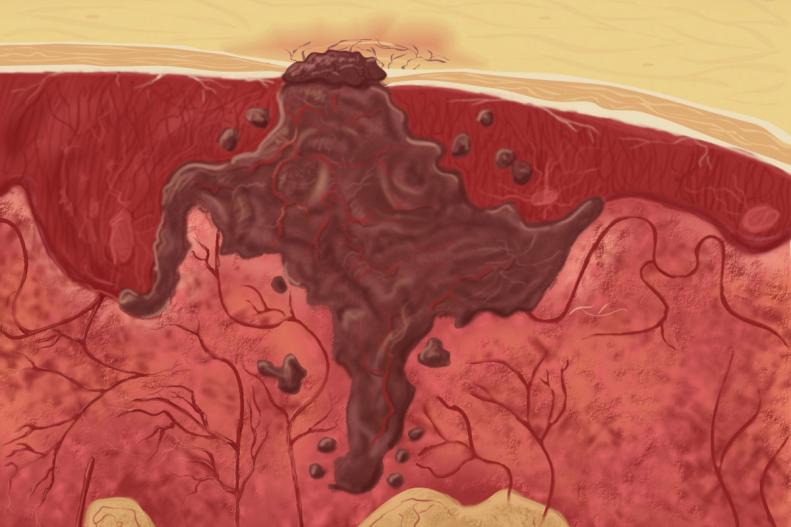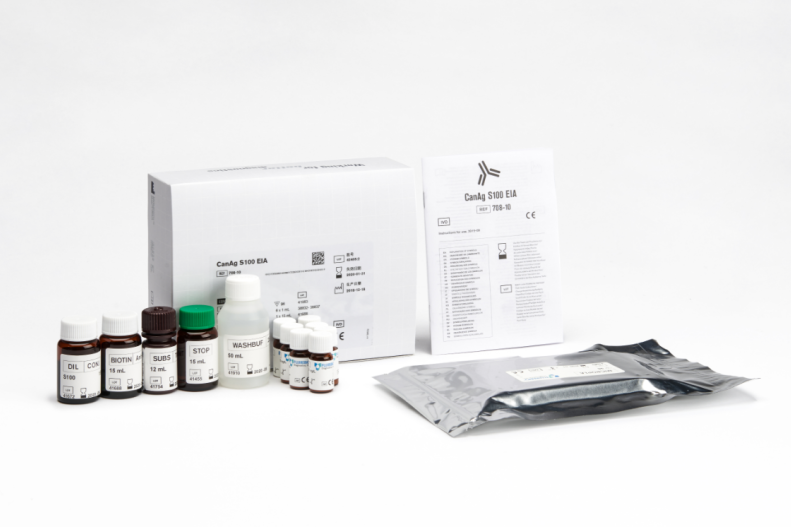CanAg® S100 EIA
S100 is a 10 kDa protein belonging to the S100/calmodulin/troponin C superfamily of EF-hand calcium-binding proteins. S100 was originally isolated from bovine brain and considered a glial-cell specific protein1. Today, 20 monomers of the S100 family have been identified based on structural and functional similarities2,3. Most of the S100 proteins exist as dimers and are expressed in a cell-specific manner. Two of the S100 monomers, designated S100A1 and S100B4 are highly conserved between species and are found as homo- (BB) and heterodimers (A1B) in central nervous system glial cells and in certain peripheral cells eg. Schwann cells, melanocytes, adipocytes, and chondrocytes (5). S100A1B and S100BB are also present in malignant tissues, most notably in melanoma and to a lesser extent in glioma, thyroid cell carcinoma and renal cell carcinoma2.
Determination of S100B in serum has been shown to be clinically useful for prognosis and treatment monitoring of patients diagnosed with malignant melanoma6-9. Studies also suggest that S100B may be useful in the management of patients with brain damage from eg. traumatic head injury, perinatal asphyxia, cardiac arrest, cardiac surgery and stroke 9-16.
References
- Moore BW (1965) A soluble protein characteristic of the nervous system. Biochem Biophys Res Commun 19:739-744.
- Zimmer DB et al., (1995) The S100 protein family history, function and expression. Brain Res Bull 37:417-429.
- Heizmann CW et al., (2002) S100 proteins:structure, functions and pathology. Front Biosci 7:1356-1368.
- Schäfer BW et al. (1995) Isolation of a YAC clone covering a cluster of nine S100 genes on human chromosome 1q21: rationale for a new nomenclature of the S100 calcium-binding protein family. Genomics 25:638-643.
- Takahashi K et al., (1984) Immunohistochemical study on the distribution of α and β subunits of S-100 protein in human neoplasm and normal tissues. Virchows Arch 45:385-396.
- Banfalvi T et al., (2003) Use of serum 5-S-CD and S-100B protein levels to monitor the clinical course of malignant melanoma. Eur J Cancer 39:164-169.
- Djureen-Mårtensson E, et al., (2001) Serum S-100b protein as a prognostic marker in malignant cutaneous melanoma. J Clin Oncol 19:824-831.
- Hauschild A et al., (1999) S100B protein detection in serum is significant prognostic factor in metastatic melanoma. Oncology 56:338-344.
- Wunderlich MT et al., (1999) Early Neurobehavioral Outcome after stroke is related to release of neurobiochemical markers of brain damage. Stroke 30:1190-1195.
- Martens P et al., (1998) Serum S100 and neuron specific enolase for prediction of regaining consciousness after global cerebral ishemia. Stroke 29:2363-2366.
- Rosén H et al., (1998) Increased serum levels of the S-100 protein are associated with hypoxic brain damage after cardiac arrest. Stroke 29: 473-477.
- Beiberthaler P et al., (2006) Serum S-100B concentration provides additional information for the indication of computed tomography in patients after minor head injury Shock 25:446-453.
- Ingebrigtsen T et al., (2000) The clinical value of serum S-100 protein measure- ments in minor head injury: a Scandinavian multicentre study. Brain Inj 14:1047-1055.
- Eric Peter Thelin et al., (2017) A review of the clinical utility of serum S100B protein levels in the assessment of traumatic brain injury. Acta Neurochir (2017) 159:209–225.
- Michetti F and Gazzolo D (2002) S100B protein in biological fluids: A tool for perinatal medicine Clin Chem 48:2097-2104.
- Anderson R et al., (2001) High serum S100B levels for trauma patients without head injuries Neurosurgery 48:1255-1258.
Product number 708-10



